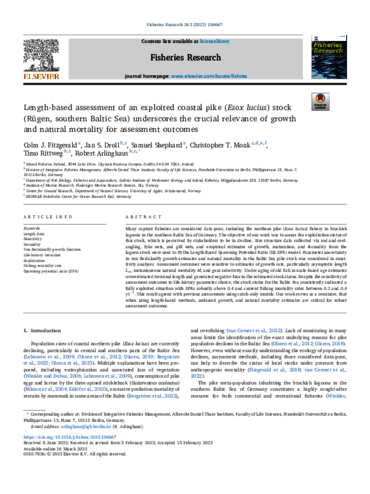Many capture fisheries are considered data-poor, including the northern pike (Esox lucius) fishery in brackish lagoons in the southern Baltic Sea of Germany. The objective of our work was to assess the exploitation status of this stock, which is perceived by stakeholders to be in decline. Size structure data collected via rod-and-reelangling, fyke nets, and gill nets, and empirical estimates of growth, maturation, and fecundity from the lagoon stock were used to fit the Length-Based Spawning Potential Ratio (LB-SPR) model. Parameter uncertainty in von Bertalanffy growth estimates and natural mortality in the Baltic Sea pike stock was considered in sensitivity analyses. Assessment outcomes were sensitive to estimates of growth rate, particularly asymptotic length L∞, instantaneous natural mortality M, and gear selectivity. Under-aging of old fish in scale-based age estimates overestimated terminal length and generated negative bias in the estimated stock status. Despite the sensitivity of assessment outcomes to life-history parameter choice, the stock status for the Baltic Sea consistently indicated a fully exploited situation with SPRs robustly above 0.4 and current fishing mortality rates between 0.2 and 0.4 yr-1. This result agreed with previous assessments using catch-only models. Our work serves as a reminder, that when using length-based methods, unbiased growth, and natural mortality estimates are critical for robust assessment outcomes.
Length-based assessment of an exploited coastal pike (Esox lucius) stock (Rügen, southern Baltic Sea) underscores the crucial relevance of growth and natural mortality for assessment outcomes
Projekt Boddenhecht , Rezensierter Artikel

Fitzgerald, C. J., Droll, J. S., Shepard, S., Monk, C. T., Rittweg, T., Arlinghaus, R. 2023. Length-based assessment of an exploited coastal pike (Esox lucius) stock (Rügen, southern Baltic Sea) underscores the crucial relevance of growth and natural mortality for assessment outcomes. Fisheries Research, 263, 106667.
Veröffentlicht
: 2023
Erschienen in
: Fisheries Research, 263, 106667
